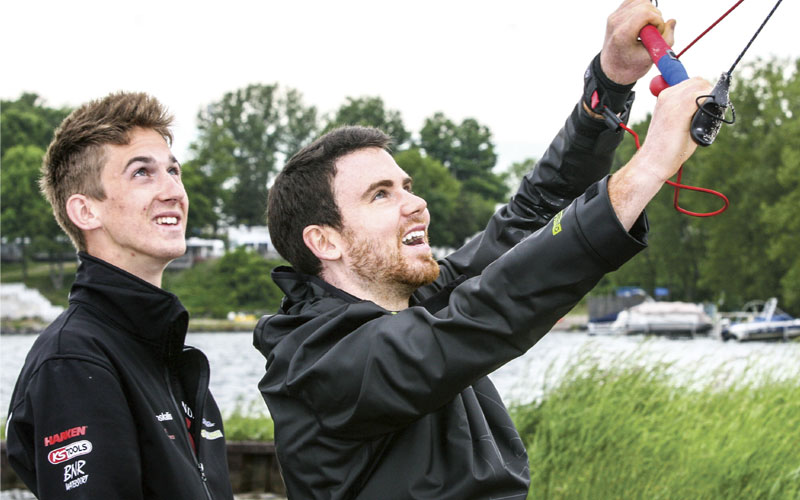County News
Learning to fly


After some guidelines and safety training, kiteboarding instructor Erik Koning (L) gives the learner’s kite to Jordan Maclean who, along with his friend Tyler Cemval, drove from Kingston for their first three-hour lesson.
Summer Company program helps new business lift off
Erik Koning likes to play on the water. He grew up on West Lake—sailing, wakeboarding and swimming. A few years ago, the 20-year-old learned to kiteboard— like wakeboarding but rather than being pulled by a boat, he is propelled across the water by a specially designed kite.
“It is the perfect marriage of sailing and wakeboarding,” says Koning.
He became proficient and soon wanted to teach others. A year ago, he trained in California and became certified as an assistant trainer. Recently, he travelled to the Dominican Republic and became a fully certified level-one instructor under the auspices of the International Kiteboarding Organization.
In the meantime, he learned about a new young entrepreneur program sponsored by the municipality and managed by the Ontario Small Business Centre (OSBC), headed locally by Sandy Abbott. The Summer Company program targets students returning to school looking to establish a summer business.
Koning submitted his business plan and his proposal was accepted
“Erik wrote a great business plan and has lots of support in both the industry and local community,” said Sandy Abbott. “We are expecting a very successful summer ahead!”
With some funds and guidance from the Summer Company program, Koning has established Airtime Kiteboarding to teach and instruct beginners in the fastest-growing watersport in the world.
No one in the area is teaching it,” explained Koning. “I really want to see the sport grow in this area. It is an activity that anyone who is reasonably fit and healthy can do. I’ve seen 80-yearolds zipping around and having a blast.”
Like any sport, there are more intense participants who find thrill on the edge, but Koning says that once someone develops the basic skills and safety procedures, most people can enjoy kiteboarding just cruising across the lake, carried by the wind.
The only restriction is that beginners must be at least 12 years old and be able to swim 50 metres.

(Background L-R): Jordan Maclean, Erik Koning and Tyler Cemval pause from their lessons to observe as a seasoned kiteboarder passes by on West Lake on Sunday afternoon.
Once the basics are mastered, even beginner kiteboarders can guide their movements with surprising precision—turning 180 degrees on a dime—zig-zagging across the lake with ease.
Unlike wakeboarding, where all the propulsion is lateral—participants are tethered to a power boat across the water— kiteboarding propulsion is directed upward. That means that more experienced and daring kiteboarders can execute massively high jumps—literally carried up and through the air by the kite.
Lessons at Airtime Kiteboarding are conducted over three days. The first day is spent almost entirely on the beach—studying safety features, hazard awareness and learning to fly the kite. Only on the second and third day do trainees venture out onto the water.
“There are quick releases everywhere,” said Koning. “These must be practiced until they become muscle memory.”
Chief among them is the quick release for the kite—detaching three of four lines to the sheet. Instantly the kite is drained of power—yet it is still attached by one line, a precaution against it sailing across the lake.
Next up comes an important lesson on working with the wind. If the wind is coming from the west, the kiteboarder works entirely in an arc running north to south. Maintaining the kite lower on the arc reduces power. As the kite rises toward the apex, more power is available and therefore more speed at their fingertips. Experienced kiteboarders use this power to execute a jump or trick—beginners tend to fall rather ungracefully into the drink when they venture too near the top of the wind’s power.
Koning preaches the importance of understanding potential threats and hazards before entering the water, including swimmers, docks and other watercraft, though kiteboarders prefer wind, something kayakers and canoeists tend to avoid.
He maintains an assortment, a quiver, of kites and boards to suit a variety of wind types and skill levels.
Koning is off to Queen’s University in the fall, studying computer sciences. But every windy day between now and then, Koning will be on the water sharing the thrill of kiteboarding.

Comments (0)